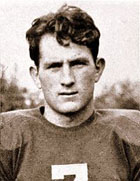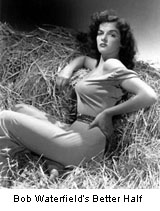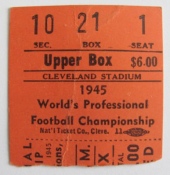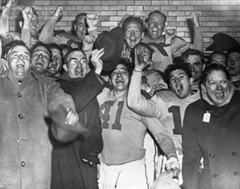 Browns Archive
Browns Archive  Homegrown Foes: The Forgotten Saga of the Cleveland Rams, Pt 1
Homegrown Foes: The Forgotten Saga of the Cleveland Rams, Pt 1

Considering the almost eerie lack of intrigue surrounding this weekend's Browns vs. Rams showdown in Cleveland, it seems a fitting time to revisit the Hollywood-level drama that originally intertwined and defined these once proud franchises some 60 years ago. It's a story that begins chronologically with the Rams, but geographically in Cleveland-- with an epic twist book-ended by two of the greatest games in football history-- the 1945 and 1950 NFL Championships.
More than likely, we have all had that recurring pipe dream in which today's expansion Browns miraculously take the AFC Championship over their former selves-- the Ravens-- in a transcendental battle of good vs. evil and ego vs. id, thus restoring balance to the force and glory to Cleveland, etc etc. What most of us fail to realize, however, is that this seemingly ridiculous scenario actually DID play out-- under almost identical circumstances-- over half a century ago. There was a beloved Cleveland team, a controversial exodus, a new beginning, and-- for the lucky fans of that bygone era-- a thrilling and satisfying final showdown. But to fully appreciate what the Browns helped Cleveland regain in 1950, you have to start by looking back at what the city had lost... it's first true NFL love, the Cleveland Rams.
Introducing Your Cleveland Rams
Nearly a decade before Paul Brown’s legendary squad made its debut in the upstart All-America Football Conference, the Rams had already been introduced as Cleveland’s shiny new representative in the well-established National Football League. From 1937 to 1945, the monstrous (and relatively new) Municipal Stadium would serve as the primary home of the Rams and the headquarters for a vital era in Cleveland football that now seems largely forgotten-- shipped off to Los Angeles, perhaps, with the rest of the team's gear.
In many respects, the odds were stacked up against the Cleveland Rams from the get-go. While professional football was on the rise in the ‘30s, the country was in the midst of the Great Depression and on the doorstep of World War II. Even in the NFL—the most stable pro football league by a wide margin—it was hardly unusual for teams to fold overnight under the strain of mounting debts. The Rams themselves had actually played their first season, 1936, in an early version of the American Football League. But as a good indicator of the times, their scheduled Championship Game matchup with the Boston Shamrocks was canceled when the Boston players refused to step on the field, citing unreceived paychecks. As a result, the Rams won the title by default, even though the Shamrocks (owners of the best record in the league) are usually credited as the league champs in most subsequent records. Meanwhile, there were several other AFL teams that actually moved or shut down operations in the middle of that 1936 season, which tells you about all you need to know.
Fortunately, the following year saw Cleveland lawyer Homer Marshman and his business associates pay $10,000 to retain ownership of the Rams franchise and jump to the legitimacy of the NFL, replacing the departed St. Louis Gunners in the league’s Western Division.
 Only four players were carried over from the original Rams, and the team got off to a predictably inauspicious start, finishing 1-10 while splitting its games between League Park and Cleveland Stadium. In 1938 (a 4-7 season) they were forced to play several home games on Shaw High School’s field, and in 1939—despite the best efforts of MVP halfback Parker Hall—the Rams still managed no better than third in the division. After another mediocre campaign in 1940, Marshman claimed to be hemorrhaging money trying to keep the franchise afloat, and he finally sold the Rams to grocery magnate Daniel Reeves and Fred Levy, Jr. for $100,000 (an ROI that looked pretty good at the time). The new ownership quickly showed signs of awakening the sleeping giant that was Cleveland’s football fan-base, as the Rams stirred up some interest with a pair of wins to open the 1941 season. But by December, the team had dropped nine straight, and thanks to a day that would live in infamy, the public’s attention had shifted to far more pressing matters.
Only four players were carried over from the original Rams, and the team got off to a predictably inauspicious start, finishing 1-10 while splitting its games between League Park and Cleveland Stadium. In 1938 (a 4-7 season) they were forced to play several home games on Shaw High School’s field, and in 1939—despite the best efforts of MVP halfback Parker Hall—the Rams still managed no better than third in the division. After another mediocre campaign in 1940, Marshman claimed to be hemorrhaging money trying to keep the franchise afloat, and he finally sold the Rams to grocery magnate Daniel Reeves and Fred Levy, Jr. for $100,000 (an ROI that looked pretty good at the time). The new ownership quickly showed signs of awakening the sleeping giant that was Cleveland’s football fan-base, as the Rams stirred up some interest with a pair of wins to open the 1941 season. But by December, the team had dropped nine straight, and thanks to a day that would live in infamy, the public’s attention had shifted to far more pressing matters.
Many of the Rams (including owners Reeves and Levy) were enlisted in the military by 1942, and in ’43, the team was so undermanned that it was actually forced to sit out the entire season. The organization regrouped for another disappointing effort in 1944, but a year later, Reeves (now as principal owner) would celebrate VJ Day with as much renewed hope as anyone. The end of the war had also marked a new beginning for his football team, highlighted by the addition of first round draft pick Bob Waterfield— a former star quarterback at UCLA and another in a long line of anointed saviors for a beleaguered Cleveland franchise.
Bob Waterfield: Cleveland's Shooting Star
 By 1945, the Rams had narrowly survived a depression, a world war, an ownership change, and seven consecutive losing seasons. Now, at the dawning of a new golden era in football and America as a whole, Bob Waterfield and Co. were poised to deliver Cleveland to the top of the NFL. Incredibly, they achieved their goal. But even more incredibly, it’s a feat that would be almost instantly jettisoned from Cleveland's supposedly elephantine sports memory—replaced instead with visions of an infant franchise from a rebel league with a local coaching legend at the helm.
By 1945, the Rams had narrowly survived a depression, a world war, an ownership change, and seven consecutive losing seasons. Now, at the dawning of a new golden era in football and America as a whole, Bob Waterfield and Co. were poised to deliver Cleveland to the top of the NFL. Incredibly, they achieved their goal. But even more incredibly, it’s a feat that would be almost instantly jettisoned from Cleveland's supposedly elephantine sports memory—replaced instead with visions of an infant franchise from a rebel league with a local coaching legend at the helm.
By 1945, former Massillon High School and Ohio State coach Paul Brown had already been named head coach and general manager of a new professional team that would serve as a founding franchise of the All-America Football Conference in 1946. The as-yet unnamed club would be playing its home games in Municipal Stadium and theoretically making a direct run at the dwindling fan-base of the hard-luck Rams. By most accounts, the Rams would need a miracle season to turn the tide and fend off the demise of the franchise. By the fall of ’45, it seemed as though their miracle had arrived in the form of Waterfield—a player not only strong-armed and skilled enough to turn around the Rams’ fortunes, but marketable enough to transcend his sport and expand the local fan-base like no one before him.
Waterfield was the classic California pretty boy, fresh out of UCLA and already married to a Hollywood starlet (his high school sweetheart Jane Russell). But unlike many of the QBs cut in his mold, he had the talents to warrant his celebrity. Waterfield led the Rams to four straight wins out of the gate in 1945, and in an era when the aerial attack was still a novel concept, he and star receiver Jim Benton were emerging as a lethal combination, terrorizing opposing defenses and earning the devotion of the Cleveland faithful. Together, they overwhelmed the Bears at Wrigley Field 41-21, upended the Packers twice by 13-point margins, and rewrote the record book on Thanksgiving Day at Briggs Stadium in Detroit, as Waterfield connected with Benton 10 times for 303 yards and a touchdown in a 28-21 Rams win. The rejuvenated Rams would finish the season a league-best 9-1, setting up a showdown with the East Division Champion Washington Redskins.
The 1945 NFL Championship: Last Stand of the Cleveland Rams
The Rams' Adam Walsh had been named Coach of the Year, Waterfield was the first unanimous MVP of the league, and Municipal Stadium was going to play host to its first ever NFL Championship Game on December 16, 1945. Not surprisingly, the Rams were the talk of Cleveland, but sadly, it wasn’t for all the right reasons. By now, it had become almost a foregone conclusion—despite the success of the team-- that owner Dan Reeves (no relation to the equally unlikeable Broncos coach) would move the Rams 2,000 miles away to Los Angeles for the following season, creating one of the first major pro sports franchises west of St. Louis. This inevitability was the dark cloud hanging over the icebox that was Cleveland Stadium, as 32,000 shivering fans filed in for a funeral march in the guise of a holiday party.

The game itself would go down as one of the most memorable of the era. With a field temperature hovering around -8 degrees, the confident rookie Waterfield squared off with another future Hall of Fame QB in the form of Washington’s already legendary Sammy Baugh. Unfortunately for Baugh, the 1945 Championship Game would be remembered as a career low point.
In the first quarter, with the game scoreless and the Redskins backed up at their own five yard-line, Baugh (who was also Washington’s punter) was forced into the endzone to scoop up a botched snap on fourth down. Thinking on his toes, he then went back into QB mode, trying to spin something from nothing, but his off-balance pass ricocheted off the crossbar (remember the goal posts were on the goal line back then) and plopped back down on the frozen turf. By rule, such a play automatically resulted in a safety, giving Cleveland a 2-0 lead. In a game that was eventually decided by just a single point, the controversial rule became a hot topic over the offseason, and the NFL elected to identify all future crossbar deflections in the endzone as deadball imcompletions rather than safeties. Most people would call it the Baugh Rule.
Of course, this was of no help to Baugh at the time, and by the second quarter, a 1-for-6 passing performance and badly bruised ribs landed the Skins captain on the bench. Backup Frank Filchock filled in admirably, tossing a 38-yard TD pass to put Washington ahead. But Cleveland reclaimed the edge just before the half when Waterfield and Benton answered with a 37-yard TD hookup of their own, topped off by a Waterfield extra-point kick that some say hit the crossbar twice before tumbling over. Halftime score: 9-7 for the home team.
 In the third quarter, Waterfield connected with halfback Jim Gillette for a 44-yard touchdown strike. Bob shanked the extra point this time, though, making it a 15-7 Rams lead. Filchock remained in for Baugh and led the Skins on another touchdown drive to get within a point at 15-14 heading into the fourth quarter. But after Washington kicker Joe Aguirre failed to convert two separate go-ahead field goals on the slippery Cleveland Stadium sod, the Rams ran out the clock and celebrated their first NFL Championship, sending the wind-whipped, bundled-up Cleveland fans into a frenzy—albeit it a bittersweet one. A bittersweet frenzy? Sure, why not?
In the third quarter, Waterfield connected with halfback Jim Gillette for a 44-yard touchdown strike. Bob shanked the extra point this time, though, making it a 15-7 Rams lead. Filchock remained in for Baugh and led the Skins on another touchdown drive to get within a point at 15-14 heading into the fourth quarter. But after Washington kicker Joe Aguirre failed to convert two separate go-ahead field goals on the slippery Cleveland Stadium sod, the Rams ran out the clock and celebrated their first NFL Championship, sending the wind-whipped, bundled-up Cleveland fans into a frenzy—albeit it a bittersweet one. A bittersweet frenzy? Sure, why not?
Not too many players go out on a high note, let alone whole teams, but in this rare instance, the ’45 Championship would indeed be the Rams swansong in Cleveland. By the start of the 1946 season, the defending champs would call L.A. home— transforming their image and expectations in the process--- while a scorned Cleveland football community would quickly rally around its new team, the Browns, and a new goldenboy QB, Otto Graham. As it turned out, however, Cleveland’s AWOL ex-idol Bob Waterfield had not yet played his final game in Municipal Stadium. Instead, he was five years away from a fateful date with bizarro déjà vu—that rarest of human events in which one re-experiences a key moment in their life from the polar opposite vantage point. For Bob, it would come in the form of the 1950 NFL Championship Game-- arguably the greatest game ever played in Cleveland, Ohio.
Coming up in Part II: Cleveland’s New Football Love Affair is Threatened When the Rams Return to Town… This Time, as the Enemy! Da da Da!
- NBA Announces 2013-2014 Schedule
- Browns Ink Sharknado
- Sharknado A No-Show For Rookie Camp
- Trent Richardson Out Until Training Camp
- Browns Sign Brandon Jackson
- Carrasco Suspended Eight Games
- Browns Add to Wide Receiver Depth with David Nelson
- Browns Need to Learn from Past Draft Mistakes
- Browns Release Chris Gocong and Usama Young
- Browns Missing on Grimes Disappointing, But Not The End
The TCF Forums
- Movies coming out
rebelwithoutaclue (Tuesday, January 21 2014 12:56 PM) - 2015 Recruiting
jclvd_23 (Tuesday, January 21 2014 12:38 PM) - The 2014 Offseason Thread
Larvell Blanks (Tuesday, January 21 2014 12:25 PM) - Official- Browns Coach Search/Rumors
Larvell Blanks (Tuesday, January 21 2014 11:53 AM) - Chris Grant's first 3 drafts
Kingpin74 (Tuesday, January 21 2014 10:13 AM) - Mike Brown
YahooFanChicago (Monday, January 20 2014 11:15 PM) - 2014 Hoops Hockey Hijinx
jpd1224 (Monday, January 20 2014 4:44 PM) - 2014 Recruiting
jclvd_23 (Monday, January 20 2014 2:26 PM) - Wish List - #4 Pick
Hikohadon (Monday, January 20 2014 1:26 PM) - #1 overall pick Anthony Bennett
TouchEmAllTime (Sunday, January 19 2014 1:28 PM)


